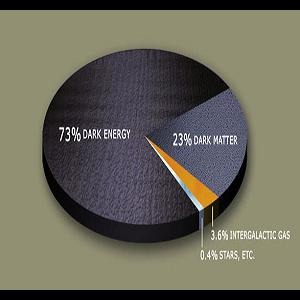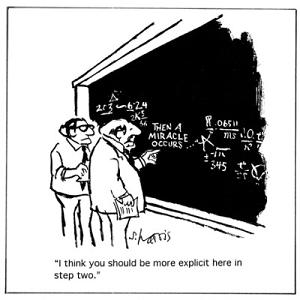4 of the Biggest Unanswered Questions in Science
 | | Hugh Jackman: inexplicable to scientists |
Not long before Einstein crashed the party, it was a common view in science that all the big questions had been answered. All that was left was a little sweeping up here and there and a whole lot of taxonomy. Scientists today chuckle nervously when you bring this up, because the common view in scientific circles nowadays is that what we know is vastly outweighed by what we don't.
A hundred years ago, they figured out that the speed of light is constant, no matter which direction you are moving in, and those who accepted this truth shrugged it off as weird and focused on the mating habits of giant ground sloths. It was Einstein who used this weird truth to revolutionize science and give birth to a whole new age of understanding and progress. In fact, the history of scientific discovery is marked by oddities that couldn't be explained. People couldn't explain the unusual orbits of the planets and sun, so Galileo suggested that the Earth wasn't the center of the universe; people couldn't explain why things fell to the ground, so Newton came up with the theory of gravity; people couldn't explain the variety of life on the planet, so Darwin wrote On the Origin of Species; people couldn't explain the actions of subatomic particles, so quantum mechanics was born.
Therefore, if you are looking for the next revolution to rock the foundations of science, you need only look at the big question marks out there. Listed below are four of the biggest, each in a different scientific discipline. Granted, you probably can't figure out the answer any more than the experts, but remember, Einstein was a patent clerk who came up with the theory of special relativity without the help of any formal scientific knowledge. For him, it was just a thought experiment.
Astrophysics
DARK MATTER AND DARK ENERGY
| 
The universe is actually a big PowerPoint presentation, and all of us are just "ETC." |
Astrophysics
DARK MATTER AND DARK ENERGY
| 
The universe is actually a big PowerPoint presentation, and all of us are just "ETC." |
It turns out that, if you use the well established mathematics of Newtonian and relativistic physics, our universe isn't acting right. Galaxies aren't spinning at the right rate and are rushing apart from each other at an inexplicably accelerating rate. The only way a long string of similar mathematical anomalies can be explained, it seems, is if the universe is made up of much more than we can currently observe. Take all the matter and energy we know about in the universe, and apparently that only makes up about 4% of what really exists. I'm not talking about stuff out beyond the visible boundaries; dark matter, by necessity, should be waiting to be discovered right outside the solar system, and dark energy should be all around us (between you, me, the tree, the rock, everywhere, yes).
The thing is, we don't know what dark matter or dark energy are. Not a clue. There are a couple of theories, of course. For dark matter, astrophysicists spend great effort in arguing for WIMPs (Weakly Interacting Massive Particles) or MACHOs (Massive Astrophysical Compact Halo Objects). Other whimsical terms thrown around are RAMBOs (Robust Associations of Massive Baryonic Objects) and DUNNOs (Dark Unknown Nonreflective Nondetectable Objects).
For dark energy, there are no cute acronyms. If dark energy is a constant energy that permeates everything, then they tend to call it the cosmological constant, in reference to a mathematical cheat used by Einstein. Ironically, Einstein, upon learning that the universe is expanding, considered the cosmological constant his biggest professional blunder, but after he died and it was discovered that the expansion is accelerating at an alarming rate, it turned out Einstein's biggest blunder was even more ahead of its time than Einstein's other ideas. However, dark energy could be something a little different, in which case scientists might call it moduli or quintessence. But if you ask them what "quintessence" means or what the cosmological constant actually is, they'll just shrug their shoulders and say it's some form of dark energy.
Biology
THE PROTEIN PROBLEM
| 
A "simple" protein |
Biology
THE PROTEIN PROBLEM
| 
A "simple" protein |
As long as there are proteins and DNA, the emergence of life can be almost completely explained by science. Once there were both DNA and the requisite proteins for life to exist, life existed, flourished, and eventually evolved into every living thing we know. The problem, though, is that we have no idea where DNA originated or how amino acids were able to fold themselves into the impossibly complex proteins that DNA exploits to create life. It is statistically impossible for these things to have emerged spontaneously at the same time with enough facility to begin the long chain of creation, and that is an understatement.
Take myoglobin, for example, an essential protein for vertebrate life. Myoglobin is a common protein chain of only 153 amino acids (keep in mind that, as proteins go, this is a very low number) in a specific order and orientation. For this to have been created randomly by amino acids bumping together, all 153 amino acids would have had to have been aligned at just the right moment. For this to happen by accident is inevitable, of course, but would statistically take so long to happen just once that the universe would have expanded and cooled to the point that nothing but protons would exist. And even if this happened miraculously quickly, there is no reason that the myoglobin would replicate itself; that's what DNA does. And what are the chances that DNA would spontaneously create itself, especially in a world without complex proteins? The answer is several orders of magnitude lower than the chances of myoglobin creating itself before the death of the universe.
And that's a problem, indeed. Aside from those who say God did it, nobody has an explanation for how both DNA and proteins came to be, especially so quickly after the formation of the Earth. There is the theory of panspermia that posits that the building blocks of life were planted here from an alien source, but even this wild theory fails to explain where they came from in the first place and thus does not actually solve the problem. Scientists aren't good at accepting divine or alien intervention, so they are working on this. Unfortunately, in a hundred years, they haven't come up with much.
Geology
POLE SWITCHING
| 
The real reason for geomagnetic reversal |
Geology
POLE SWITCHING
| 
The real reason for geomagnetic reversal |
Geologists in the 1920's noticed something odd about ancient rocks. Every so often in the strata (equivalent to every 50-780 thousand years), magnetic rocks would suddenly reverse their orientation. The only reason this would happen is if the Earth's magnetic field suddenly switched so that North became South and South became North. Many considered this a fringe idea and didn't put much credance in it. At the time, the whole of geology was undergoing a difficult transformation into a science based on plate techtonics, so nobody wanted to talk about anything more bizarre and inexplicable than the notion that the continents are moving around under our feet.
Today, pole switching (known more scientifically as "geomagnetic reversal") is considered scientific fact, but few can agree on its causes. Some think it's just one of those things that happens when the Earth's magnetic field weakens and others think it happens after something big like a solar flare or meteor messes with us. Still, at the end of the day, all the theories are just guesses based on deduction and scanty evidence, so the truth behind pole switching remains a big, fat question mark.
Even more disturbing, though, is that nobody knows when it will happen again, how long it will take, or if it will affect us that much. In the worst case scenario, the magnetic field could vanish altogether, exposing us to deadly cosmic rays and the dangerous whims of the sun, and it could take the Earth a few thousand years to reestablish its protection. On the other hand, it could happen very suddenly and the only side effect would be a few thousand baffled airline pilots, sea captains, and boy scouts learning that needle compass trick. Some say that there is no evidence that geomagnetic reversal has ever caused an extinction event, but this is hardly comforting as we don't actually know what caused 90% of the extinction events on record and our known geological timetable isn't as certain as you probably think.
Quantum Mechanics
INSTANTANEOUS NONLOCAL INTERACTIONS
| 
(Cartoon by Sidney Harris) |
Quantum Mechanics
INSTANTANEOUS NONLOCAL INTERACTIONS
| 
(Cartoon by Sidney Harris) |
The rule is that nothing can move faster than the speed of light. Even the tiniest particle would aqcuire infinite mass upon reaching that speed, and would thus require an infinite amount of energy in order to keep moving. This doesn't even take into account the fact that, if you were to travel any faster, you would find yourself traveling backwards in time. It just can't be done, and the vast majority of scientists believe that to this day. There's only one problem: it has been experimentally verified multiple times that, at the quantum level, information can travel between two distant points instantaneously.
By all laws of known physics, this just shouldn't be. Granted, you can't exploit this quantum trick in any meaningful way, so it doesn't mean we can set up instant communication with Alpha Centauri any time soon. Still, the fact remains that, if you change a quantum particle (by measuring it) that happens to have a distant partner, the distant partner will immediately snap into a complimentary alignment. It doesn't matter if the two particles are a few feet away or separated by the entire gulf of the universe.
And that's not the only example in quantum physics of things moving faster than the ultimate speed limit. It's a little difficult to wrap your brain around, but at a quantum level, particles exist in many places at once. Electrons, for example, don't orbit in neat little circles and jump from orbit to orbit the way we were taught in high school; they actually exist in a cloudy realm around the nucleus where they exist in every possible location they can inhabit (this is true). When they change orbital shape, they disappear entirely and instantaneously reappear in the new orbit (this is where the term "quantum leap" originated, not with Scott Bakula as is commonly believed). The thing is, the possible locations of a particle that is not married to an atom can be separated by light years, and yet, when the particle is measured and assigned a true location, it immediately ceases to exist elsewhere.
Scientists have absolutely no explanation for any of this. They don't even have a theory. Even M-Theory, the most complex and mind-bending concept on the fringes of theoretical physics, cannot explain how quantum particles can transfer information faster than the speed of light. As Albert Einstein himself said, it's just plain "spooky."
-e. magill 09/29/2009
|
|